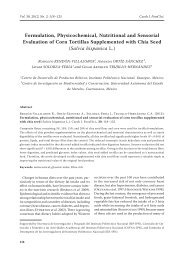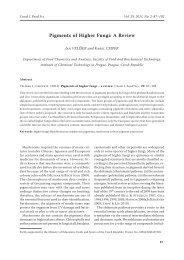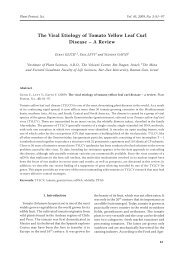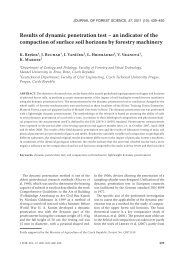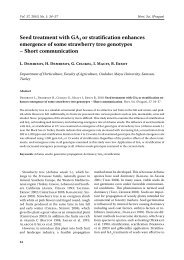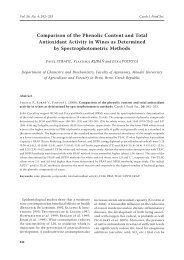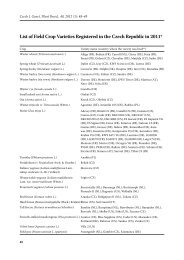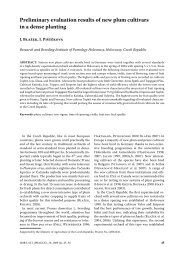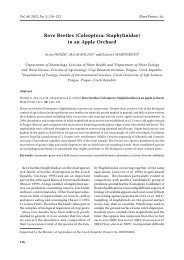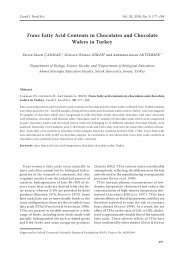fulltext - Agricultural Journals
fulltext - Agricultural Journals
fulltext - Agricultural Journals
Create successful ePaper yourself
Turn your PDF publications into a flip-book with our unique Google optimized e-Paper software.
Vol. 56, 2010, No. 1: 8–17<br />
Res. Agr. Eng.<br />
Exploitation of anaerobic fermentation of bio-degradable<br />
wastes<br />
J. Kára, E. Janča, D. Herák<br />
Department of Mechanical Engineering, Faculty of Engineering,<br />
Czech University of Life Sciences in Prague, Prague, Czech Republic<br />
Abstract<br />
Kára J., Janča E., Herák D., 2010. Exploitation of anaerobic fermentation of bio-degradable wastes. Res. Agr.<br />
Eng., 56: 8–17.<br />
The paper deals with assessment of biogas yield from mixtures of Reynoutria substrates and livestock manure. The aim<br />
was to perform laboratory experiments and suggest suitable fermenter operating conditions (dry matter content, pH,<br />
share of substrate components, thermic regime) for metanogenic digestion, then to determine its quality and assess<br />
the usability of such produced biogas.<br />
Keywords: biogas; biogas station; renewable energy resources; combined heat and power period<br />
As the existing sources of fossil fuel are exhaustible,<br />
it is necessary to replace them as far as possible<br />
by renewable and alternative resources of energy,<br />
such as biogas (Trnobranský 1998). It can realistically<br />
be anticipated that world prices of fossil fuel<br />
will increase. It has been stated that whereas the<br />
three first crude oil crises were caused by wars taking<br />
place near crude oil fields, the last crisis was fully<br />
due to excess of demand over supply. People have<br />
already used one half of crude oil resources, and<br />
at the present (or even increasing) rate of exploitation<br />
the supplies will be exhausted within 30 years<br />
(Váňa 2001).<br />
When dealing with the problem of power-producing<br />
exploitation of bio-wastes one has to start from<br />
economic aspect: which are determining factors in<br />
this case; but also to take into account ecology aspects<br />
in order not to impose additional burdens on environment.<br />
The energy problem of greenhouse effect<br />
that the world population is facing does not merely<br />
consists in the question what type of power stations<br />
should be built (whether for fossil fuel or for nuclear<br />
fuel) but in the fact that it is impossible to further release<br />
any type of energy for power or heat production,<br />
transport etc., because heat emissions from human<br />
activities have already exceeded tolerable limits<br />
in some regions. People will inevitably have to learn<br />
to live more economically and to use annually worldwide<br />
about 10 15 to 10 16 kWh from clean and safe energy<br />
sources, and also annually obtain 10 16 kWh directly<br />
from solar energy (Cenka 2001).<br />
Although the exploitation of bio-wastes for power<br />
production also has its seamier side, it is impossible<br />
not to make use of this possibility to solve the<br />
energy problems at least partially, particularly in<br />
regions where there have been created corresponding<br />
conditions for it. The development of utilisation<br />
of bio-wastes for power production fully agrees<br />
with “Czech energy policy”. Bio-wastes are processed<br />
in fermentation reactors to produce biogas,<br />
which also restricts some negative properties of the<br />
excrements and thus increases their quality.<br />
Supported by Ministry of Agriculture of the Czech Republic, Project No. QF 3160.
Res. Agr. Eng. Vol. 56, 2010, No. 1: 8–17<br />
The principle of biogas production has been<br />
known since the 19 th century and has been sufficiently<br />
proved in the 20 th century in the area of municipal<br />
sewage plants (Haš et al. 1985).<br />
One of the first technological devices for sludge<br />
stabilisation was put into operation in France in<br />
1881: in principle it consisted in a digestion and<br />
sedimentation tank (nowadays called a cesspit).<br />
Equipment for purification of municipal sewage<br />
water was constructed in England in 1891. This appliance<br />
consisted of a tank with horizontal metal<br />
grid carrying a layer of pebbles in the middle; the<br />
sewage water was introduced into the lower part of<br />
the tank, where the sludge sedimented and the water<br />
moved up wards and passed through the pebble<br />
layer, which operated as a filter. The sludge was periodically<br />
removed from the bottom of the tank,<br />
and biogas was then released from it spontaneously<br />
in a non-controlled process.<br />
A turning point in development came in 1924,<br />
when an independent anaerobic purifying tank was<br />
constructed in Germany: in this case the sludge was<br />
warmed by means of burning the released biogas.<br />
In following years, these technologies undergone<br />
a number of improvements and valuable experience<br />
was obtained from their operation. Gradually, this<br />
technology of biogas production was introduced into<br />
the area of processing of excrements of livestock.<br />
Nowadays it is intended to utilise anaerobic digestion<br />
also for treatment of domestic biodegradable wastes.<br />
Within the context of biogas production and entrapping,<br />
biogas began being exploited not only for<br />
the process of septicization in itself, but also to be<br />
burnt in cogeneration units where electricity and<br />
heat are produced. Facilities based on phosphoric<br />
acid electrolyte fuel cells (PC25C) pose the most<br />
recent innovation.<br />
One of the main reasons for recent emphasizing<br />
of the renewable energy sources is the reduction in<br />
greenhouse gases (e.g. water vapor, methane, carbon<br />
dioxide etc.).<br />
Thermal conversion processes (e.g. combustion,<br />
gasification and pyrolisis) prevail during utilization<br />
of biomass for energetic purposes, but anaerobic<br />
digestion related to the production of biogas and<br />
organic fertilizers becomes increasingly applied.<br />
The process of biomass anaerobic digestion shows<br />
quite a few of environmental advantages and it is<br />
recognised as one of the technologies contributing<br />
to the sustainable development of mankind.<br />
Besides animal faeces, biogas stations can also<br />
treat scraps from crop and greengrocery production<br />
and processing, waste from slaughterhouse, dairy,<br />
fat, tanning and pharmaceutical industries, residues<br />
from biodiesel and ethanol fuel production, scraps<br />
from greenery maintenance and biodegradable part<br />
of separately collected municipal waste. Biogas can<br />
be also easily gained from anaerobic sludge stabilization<br />
and from compost degassing.<br />
Biogas is a product of anaerobic microbial biodegradation<br />
– anaerobic digestion. This process<br />
develops either spontaneously in the nature under<br />
certain circumstances, unaffected by human factor,<br />
or in special-purpose technological processes. Water<br />
presence is a precondition of anaerobic digestion<br />
and any processed material must contain sufficient<br />
amount of biodegradable substances. The engineering<br />
solution depends on the input material consistency<br />
– it is different for suspensions and dilutions<br />
(dry matter content up to 18–20%) and for solid<br />
scrapable substances (dry matter content 20–40%).<br />
Biogas is a gas mixture usually comprising 50–75%<br />
of methane (CH 4<br />
), 30–45% of carbon dioxide and 1 to<br />
3% of minority gases (e.g. nitrogen – N 2<br />
, hydrogen<br />
sulfide – H 2<br />
S, hydrogen – H 2<br />
). Water vapor (H 2<br />
O)<br />
is a variable component part of biogas. The calorific<br />
value of biogas ranges between 18 and 25 MJ/m 3 ,<br />
whereas if purified to the extent that nearly absolute<br />
methane remains (with the calorific value of<br />
35.8 MJ/m 3 ), biogas can be used as a substitution<br />
for natural gas (which usually comprises 99.9% of<br />
methane) (Jonáš, Petříková 1988).<br />
Material and methods<br />
Production of wastes in starch factories<br />
Starch factories virtually produce three types of<br />
wastes: tuber juice (from separation of starch grains),<br />
crushing cakes i.e. extracted residues of ground potatoes,<br />
and washing waters (white tuber juice).<br />
The tuber juice is composed of soluble components<br />
of potato tubers and water (sometimes it is<br />
denoted as potato juice or brown tuber water). The<br />
extraction technological water from separators of<br />
starch grains is called white tuber water. The produced<br />
tuber juices are rich in mineral substances<br />
and their composition is suitable for fertilising of<br />
some farming crops. The density of tuber juice is<br />
ca. 1,106 kg/m 3 (the interval is from 1,084 kg/m 3 to<br />
1,134 kg/m 3 ). From among organic acids, the juice<br />
contains citric acid C 6<br />
H 8<br />
O 7<br />
(0.1–0.55%, freshly<br />
harvested potatoes up to 1%), oxalic acid C 2<br />
H 2<br />
O 4
Vol. 56, 2010, No. 1: 8–17<br />
Res. Agr. Eng.<br />
(0.017–0.058%), and malic acid. The overall titratable<br />
acidity of the juice corresponds to 250–700 ml<br />
N-NaOH per 100 g; its pH value varies within the<br />
limits of 5.76–6.56 (Nordberg 1996). At present,<br />
the tuber juices are used as fertilizers. The crushing<br />
cakes are used as feed for pigs, and with regard to<br />
this fact, real starch factory wastes that can be used<br />
for biogas production are the two liquid wastes:<br />
brown and white tuber juices (waste water from<br />
starch separators). Both these liquid wastes were<br />
submitted to laboratory tests.<br />
The sludge water produced in the rinsing circuit<br />
and a part of technological water from starch production,<br />
especially rinsing waters, are led to municipal<br />
Waste Water Treatment Plant (WWTP).<br />
If we take into account the chemical composition<br />
and mechanical properties of tuber juice for potential<br />
exploitation in a biogas station, such application<br />
presents no problems and is desirable. This<br />
liquid is well pump able and not especially active.<br />
Similarly problem less application can be expected<br />
in the case of white tuber juice. The sludge waters<br />
are problematic due to considerable content of clay<br />
and sand. Therefore, before their potential exploitation<br />
in biogas station they have to be rid of these<br />
components.<br />
Reynoutria species is an invasive plant, whose invasion<br />
ability is based, first of all, on easy regeneration<br />
from rhizomes and fragments of stalks, the considerable<br />
amount of aerial biomass that is produced<br />
by this plant, massive root system, and probably also<br />
on the observed allelopathia. It particularly colonizes<br />
sites affected by man (settlements, communications,<br />
disposal sites etc.) and vicinity of larger watercourses.<br />
Another problem connected with this plant<br />
lies in the fact that it is difficult to liquidate.<br />
At its habitat it gradually creates its monoculture,<br />
which results in a biodiversity decrease. It<br />
can be especially harmful in protected zones, but<br />
it is no less unwelcome in open countryside. The<br />
main problem connected with this plant lies in its<br />
negative effect upon neighbouring vegetation; that<br />
considerably complicates its exploitation for biogas<br />
production. For its use in biogas station it has to be<br />
pre-crushed.<br />
Procedure of measurements<br />
The aim was to find out the maximum amount of<br />
the methane or biogas produced per one mass unit<br />
of the material examined → Y CH4 ,S , Y BP s (l/g, m3 /kg)<br />
(S = CHSK [chemical oxygen consumption], or V L<br />
).<br />
The mass percentage of dry matter content, from<br />
the total content of sample in the case of mixing of<br />
substrates, was 5% or 8% of dry matter content in<br />
the sample. The laboratory fermenters used were<br />
charged with materials containing the dry matter.<br />
The resulting biogas production was always related<br />
to 1 kg of total dry matter content of the sample.<br />
The measuring vessels were charged with a<br />
known amount of inoculum and a defined medium<br />
containing buffer, macro- and micro-nutrients (N,<br />
P, Fe, Co, Ni etc.). This medium prevents the deficit<br />
of nutrients to become a limiting factor in the<br />
measurements. The mixture was bubbled through<br />
with nitrogen in order to fill with nitrogen the gas<br />
volume above the level and was left to stand several<br />
hours to stabilise and adjust the required temperature.<br />
The last component that was added to this<br />
mixture was the substance investigated – the only<br />
source of carbon for the anaerobic culture present;<br />
before the addition, the temperature of this component<br />
was adjusted at the value of cultivation,<br />
and the moment of its addition (connected with<br />
equilibrating of the pressure in the vessel with atmospheric<br />
pressure) was recorded as the start of<br />
measurement. The total volume of liquid phase is<br />
then – V L<br />
.<br />
The experimental conditions adjusted in all the<br />
runs were the same. The tested substrates were cultivated<br />
in the fermenters at a constant temperature<br />
of 42°C (mesophilic region) and the content was<br />
discontinuously stirred. For comparison, other fermenters<br />
were also kept at the temperatures of 46°C<br />
and 55°C (thermophilic region). At definite time<br />
intervals, the biogas produced was measured (once<br />
per 24 h) by means of a gas analyzer AIR LF, and<br />
volume was read at the scale on gas-holder sides.<br />
The measurement results always represented an average<br />
value from all the fermenters. If necessary, the<br />
quality of biogas was checked by chromatographic<br />
analysis of gas phase, which is very important, because<br />
CO 2<br />
and H 2<br />
are formed in the pre-methanogenesis<br />
phase if, of course, the methanogenesis<br />
phase is inhibited or blocked.<br />
The measurement was finished when the substrate<br />
production of gas was constant – when it<br />
stopped increasing with time, i.e. the efficiency of<br />
decomposition at the given conditions was at the<br />
maximum.<br />
The yield of biogas – Y BP<br />
is calculated from the<br />
substrate production of biogas – V BP<br />
s (volume difference<br />
between total and endogenic production<br />
10
Res. Agr. Eng. Vol. 56, 2010, No. 1: 8–17<br />
of biogas), divided by the initial amount of added<br />
substrate – S.<br />
Y<br />
BP<br />
=<br />
( V c −V<br />
e)<br />
BP<br />
S<br />
BP<br />
VBPs<br />
=<br />
S<br />
3<br />
m <br />
(l/g,<br />
1/<br />
gm ,<br />
3 /kg)<br />
<br />
kg <br />
Measuring instruments used<br />
(1)<br />
• Gas analyzer AIR LF. The instrument allows determination<br />
of CH 4<br />
, O 2<br />
, CO 2<br />
content, and – as<br />
the case may be – also CO and H 2<br />
S content in<br />
biogas.<br />
• Measuring centre THERM 3280 – 8M. It allows<br />
measurement of 10 quantities, temperature, humidity<br />
etc. with intensity or voltage input.<br />
• Pressure difference gauge Digima LPU. It allows<br />
measurement of pressure differences in the range<br />
of 1–5,000 Pa. The instrument was used for pressure<br />
measurements in digesting fermenters and<br />
gas pipes.<br />
• Polarograph Tribio II – 2. In the course of measurements,<br />
it was used for determination of content<br />
of trace elements in the substrate.<br />
• Laboratory oven was used for determination of<br />
dry matter content of samples and for preparation<br />
of samples before further analyses.<br />
• Gas chromatograph Chrom 5 was used for general<br />
analyses of samples. The apparatus KJELTEC<br />
SYSTEM Tecator is designed for thermo-chemi-<br />
cal mineralization, extraction and distillation for<br />
determination of N by physico-chemical measuring<br />
methods.<br />
• Spectral colorimeter SPEKOL. The instrument<br />
was used for physico-chemical measuring methods<br />
determining the P and K content in biomass.<br />
Results and discusion<br />
Evaluation of the values measured<br />
Real waste products for biogas production that<br />
can be obtained from starch factories are the tuber<br />
juice (waste from ground potatoes production)<br />
and white tuber water (waste water from starch<br />
separators). Both these materials were submitted<br />
to laboratory for investigation. Furthermore for<br />
comparison, measurements were carried out with<br />
Reynoutria species, which appears to be a controversial<br />
crop: it exhibits an excellent yield of biomass<br />
(30–50 t/ha).<br />
During both experiments of biogasification in<br />
small fermenters of 3-litres volume, reactor 1f<br />
served for control purposes, charged with no additive<br />
substance (0%). In biological experiments,<br />
control sample outputs serve as a reference, by<br />
which means possible negative influences (like undesirable<br />
contamination, inconsistent temperature<br />
conditions, inferior inoculum etc.) can be estimat-<br />
350<br />
300<br />
(l/kg dry metter) matter<br />
250<br />
200<br />
150<br />
100<br />
50<br />
0<br />
1f -– 100% Semi-Liquid semi-liquid manure Manure<br />
2f -– 90% Semi-Liquid semi-liquid manure Manure + 10% tuber Tuber juice Juice<br />
3f -– 80% Semi-Liquid semi-liquid manure Manure + 20% tuber Tuber juice Juice<br />
4f -– 70% Semi-Liquid semi-liquid manure Manure + 30% tuber Tuber juice Juice<br />
5f -– 60% Semi-Liquid semi-liquid manure Manure + 40% tuber Tuber juice Juice<br />
1 3 5 7 9 11 13 15 17 19 21 23 25 27 29<br />
Day day<br />
Fig. 1. Cumulative production of biogas (fermenters of 3-litre volume); tuber juice<br />
11
Vol. 56, 2010, No. 1: 8–17<br />
Res. Agr. Eng.<br />
(l/kg kg dry dry metter) matter<br />
300<br />
250<br />
200<br />
150<br />
100<br />
50<br />
0<br />
1f 1f - – 100% 100% Semi-Liquid semi-liquid Manure manure<br />
2f 2f -– 90% 90% Semi-Liquid semi-liquid Manure manure + 10% + 10% White white Tuber tuber Water juice<br />
3f 3f -– 80% 80% Semi-Liquid semi-liquid Manure manure + 20% + 20% White white Tuber tuber Water juice<br />
4f 4f -– 70% 70% Semi-Liquid semi-liquid Manure manure + 30% + 30% White white Tuber tuber Water juice<br />
5f -– 60% 60% Semi-Liquid semi-liquid Manure manure + 40% + 40% White white Tuber tuber Water juice<br />
1 3 5 7 9 11 13 15 17 19 21 23 25 27 29<br />
Day day<br />
1f - 100% Semi-Liquid Manure<br />
Fig. 2. Cumulative production of biogas (fermenters of 3-litre volume); white tuber water<br />
ed during the course of experiment. Biogas production<br />
was measured daily, however cumulative<br />
production is shown for each experiment for clear<br />
interpretation.<br />
Biogas production in small fermenters was slightly<br />
higher with tuber juice (in average 300 l/kg of<br />
dry matter, Fig. 1) than with white tuber water (in<br />
average 220 l/kg of dry matter, Fig. 2). The course of<br />
biogas production is identical for all charges containing<br />
10–40% of additive substance. There were<br />
differences in the second stage only (after the 8 th day<br />
of anaerobic decompostion), characterized by<br />
lower cummulative biogas production, when the<br />
concentration of individual charges differed by approximately<br />
20 l/kg of dry matter.<br />
In large fermenters, the biogas production from<br />
these two sources was comparable, ca. 200 l/kg of<br />
dry matter, Fig. 3 (both the large fermenters operated<br />
in mesophilic region at 46°C); exact values of<br />
biogas production were 217 l/kg of dry matter from<br />
tuber juice and 190 l/kg of dry matter from white<br />
tuber water.<br />
In the initial stage of first eight days, the sample<br />
charged with white tuber water and placed in a<br />
100-litres fermenter shows higher biogas production<br />
than the sample charged with tuber juice.<br />
Nevertheless, in the following stage the the sample<br />
charged with white tuber water already lagged behind<br />
the other one in terms of biogas production.<br />
The initial stage of anaerobic decompostion is usually<br />
characterized by lower volume of methane in<br />
the biogas produced.<br />
The energy value of biogas is expressed by the<br />
methane content. The volume percentage of meth-<br />
(l/kg dry metter) matter<br />
Fermenter 1 - 70% Semi-Liquid Manure + 30% Tuber Juice; mesophilic<br />
250 process (46°C)<br />
Fermenter 2 - 70% Semi-Liquid Manure + 30% White Tuber Water;<br />
200<br />
mesophilic process (46°C)<br />
150<br />
100<br />
Fermenter 1 -1 70% – 70% Semi-Liquid semi-liquid Manure manure + 30% + Tuber 30% Juice; tuber mesophilic juice; mesophilic<br />
process (46°C)<br />
50<br />
process (46<br />
Fermenter Fermenter 22 - 70% – 70% Semi-Liquid semi-liquid Manure manure + 30% + 30% White white Tuber tuber Water; water; mesophilic<br />
process (46°C)<br />
mesophilic process (46<br />
0<br />
1 2 3 4 5 6 7 8 9 10 11 12 13 14 15 16 17 18 19 20 21 22 23 24 25 26 27<br />
Day day<br />
Fig. 3. Cumulative production of biogas (fermenters of 100-litre volume)<br />
12
Res. Agr. Eng. Vol. 56, 2010, No. 1: 8–17<br />
(%) %<br />
90<br />
85<br />
80<br />
75<br />
70<br />
65<br />
60<br />
1f -– 100% Semi-Liquid semi-liquid manure Manure<br />
- Semi-Liquid Manure + 10% Tuber Juice<br />
55<br />
2f – 90% semi-liquid manure + 10% tuber juice<br />
3f -– 80% Semi-Liquid semi-liquid manure Manure + + 20% 20% tuber Tuber juice Juice<br />
50<br />
4f -– 70% Semi-Liquid semi-liquid manure Manure + + 30% 30% tuber Tuber juice Juice<br />
45<br />
5f -– 60% Semi-Liquid semi-liquid manure Manure + + 40% 40% tuber Tuber juice Juice<br />
40<br />
1 2 3 4 5 6 7 8 9 10 11 12 13 14 15 16 17 18 19 20 21 22 23 24 25 26 27<br />
day Day<br />
Fig. 4. Amounts of CH 4<br />
in biogas (fermenters of 3-litre volume); tuber juice<br />
ane determines the calorific value of a biogas and it<br />
is one of the main criteria for the composition of a<br />
charge. The methane part by volume for the experiment<br />
with 3-litre fermenters and tuber juice is shown<br />
in the Fig. 4, the data for white tuber water experiment<br />
are shown in Fig. 5. The rest of percentage is<br />
mostly carbon dioxide content, water vapour, oxygen<br />
and sulfane can be also present in small amount.<br />
The composition of biogas was very similar with<br />
all the samples, for both tuber juice and white tuber<br />
water, both small and large fermenters. The methane<br />
content in produced biogas settled down in the<br />
70–80% range with all the samples, the peak values<br />
approaching up to the limit of 90%. The production<br />
of biogas from starch industry waste was again<br />
approximately 30% higher with smaller fermenters<br />
used, comparing to the usage of larger fermenters;<br />
this can be explained by better temperature stability<br />
of small fermenters, for whole filling and during<br />
all the retention time. The natural energy was satisfactory<br />
for all measured mass portions of starch<br />
industry waste. The charge containing 40% of tu-<br />
90<br />
80<br />
70<br />
60<br />
(%) %<br />
50<br />
40<br />
30<br />
20<br />
10<br />
1 2 3 4 5 6 7 8 9 10 11 12 13 14 15 16 17 18 19 20 21 22 23 24 25 26 27<br />
Day day<br />
1f -– 100% Semi-Liquid semi-liquid Manure manure<br />
2f -– 90% Semi-Liquid semi-liquid Manure manure + 10% White white tuber Tuber water Water<br />
3f -– 80% Semi-Liquid semi-liquid Manure manure + 20% White white tuber Tuber water Water<br />
4f -– 70% Semi-Liquid semi-liquid Manure manure + 30% White white tuber Tuber water Water<br />
5f -– 60% Semi-Liquid semi-liquid Manure manure + 40% White white tuber Tuber water Water<br />
Fig. 5. Amounts of CH 4<br />
in biogas (fermenters of 3-litre volume); white tuber water<br />
13
Vol. 56, 2010, No. 1: 8–17<br />
Res. Agr. Eng.<br />
90<br />
85<br />
80<br />
(%) %<br />
75<br />
70<br />
65<br />
60<br />
55<br />
1 2 3 4 5 6 7 8 9 10 11 12 13 14 15 16 17 18 19 20 21 22 23 24 25 26<br />
Day day<br />
Fermenter Ferm. 2 (CH4) 2 (CH- 4<br />
70% ) – 70% Semi-Liquid semi-liquid Manure manure + 30% + 30% Tuber tuber Juice; juice; (46°C)<br />
Fermenter Ferm. 2 (CH4) 2 - 4<br />
70% ) – 70% Semi-Liquid semi-liquid Manure manure + 30% white White tuber Tuber juice; Juice; (46°C) (46°C)<br />
Fig. 6. Amounts of CH 4<br />
in biogas (fermenters of 100-litre volume)<br />
ber juice showed very low concentration of methane<br />
in the second stage, which can be explained by<br />
anaerobic conditions disturbance in the reactor.<br />
The same occurred during the experiment of white<br />
tuber water charge (3-litre fermenters); again the<br />
charge with 40% white tuber water content showed<br />
very low methane concentration in the second stage<br />
of experiment. However the anaerobic conditions<br />
disturbance occurred no earlier than by the end of<br />
so-called impediment period.<br />
According to results of the measurements, the<br />
optimum yields were obtained with the ratio of<br />
70% semi-liquid manure + 30% tuber juice (white<br />
tuber water). The results gained with such mixtures<br />
were satisfactory both in terms of produced biogas<br />
volume and rapid production increase in the initial<br />
stage. The amount of CH 4<br />
obtained with this<br />
ratio was very stable, varying slightly about 80%<br />
throughout the measurement period. The result of<br />
measurements in small 3-litre fermenters was used<br />
350<br />
300<br />
(l/kg dry metter) matter<br />
250<br />
200<br />
150<br />
100<br />
50<br />
0<br />
1 2 3 4 5 6 7 8 9 10 11 12 13 14 15 16 17 18 19 20 21 22 23 24 25<br />
Day day<br />
1f –- 100% Semi-Liquid semi-liquid manure Manure<br />
2f –- 90% Semi-Liquid semi-liquid manure Manure + 10% + 10% Reynoutria<br />
3f –- 80% Semi-Liquid semi-liquid manure Manure + 20% + 20% Reynoutria<br />
4f –- 70% Semi-Liquid semi-liquid manure Manure + 30% + 30% Reynoutria<br />
5f –- 60% Semi-Liquid semi-liquid manure Manure + 40% + 40% Reynoutria<br />
6f –- 10% Semi-Liquid semi-liquid manure Manure + 90% + 90% Reynoutria<br />
Fig. 7. Cumulative production of biogas (fermenters of 3-litre volume); Reynoutria<br />
14
Res. Agr. Eng. Vol. 56, 2010, No. 1: 8–17<br />
l/ kg (l/kg dry dry matter metter)<br />
300<br />
250<br />
200<br />
150<br />
100<br />
50<br />
0<br />
Fermenter (42<br />
1 1 – -80% 70% 80% semi-liquid Semi-Liquid manure Manure + 20% + 30% 20% Reynoutria Tuber Reynoutria; (42°C) Juice; mesophilic<br />
process (42°C) Fermenter (46 2 1 –– 80% 80% semi-liquid Semi-Liquid manure Manure + 20% Reynoutria + 20% Reynoutria; (55°C)<br />
Fermenter (55 1 – 80% Semi-Liquid Manure + 20% Reynoutria;<br />
(55°C)<br />
1 2 3 4 5 6 7 8 9 10 11 12 13 14 15 16 17 18 19 20 21 22 23 24 25<br />
Day day<br />
Fig. 8. Cumulative production of biogas (fermenters of 100-litre volume); Reynoutria<br />
as the base for further experiment in large 100-litre<br />
reactors. The charges containing tuber juice as<br />
additive material showed higher methane concentration<br />
in biogas and better stability during all the<br />
impediment period, even in the experiment with<br />
100-liter fermenters used (Fig. 6).<br />
As evident from the diagram in Fig. 7, the course of<br />
biogas production for Reynoutria charges with additive<br />
material was basically identical. Some small differences<br />
were in steepness of the initial stage. Charges<br />
with content of 10%, 20% and 30% of Reynoutria<br />
as an additive material showed faster increase of production<br />
than charges with higher Reynoutria content.<br />
The charge with 90% Reynoutria content did not<br />
show satisfactory results of biogas production. This<br />
composition cannot be recommended for further applications<br />
unless some adjustments of composition<br />
or anaerobic digestion conditions are done.<br />
The highest cumulative biogas production was<br />
achieved with charge containing 20% of Reynoutria<br />
(260 l/kg of dry matter). The optimal-appearing<br />
Reynoutria concentrations from measurements performed<br />
in small 3-litre fermenters were used as reference<br />
samples for experiments with large 100-litre<br />
fermenters (Fig. 8). The large fermenters were run<br />
at 42°C (mesophilic range) and 55°C (thermophilic<br />
range) for comparison. The charge treated in thermophilic<br />
mode of fermentation showed both steeper<br />
increase and higher cumulative biogas production,<br />
comparing to the charge in mesophilic range.<br />
(%) %<br />
80<br />
70<br />
60<br />
50<br />
1f –- 100% semi-liquid Semi-Liquid manure Manure<br />
40<br />
2f –- 90% semi-liquid Semi-Liquid manure Manure + 10% + 10% Reynoutria Reynoutria<br />
3f –- 80% semi-liquid Semi-Liquid manure Manure + 20% + 20% Reynoutria<br />
30<br />
4f –- 70% semi-liquid Semi-Liquid manure Manure + 30% + 30% Reynoutria<br />
20<br />
5f –- 60% semi-liquid Semi-Liquid manure Manure + 40% + 40% Reynoutria<br />
10<br />
6f –- 10% semi-liquid Semi-Liquid manure Manure + 90% + 90% Reynoutria<br />
1 3 5 7 9 11 13 15 17 19 21 23 25<br />
Day<br />
day<br />
Fig. 9. Amounts of CH 4<br />
in biogas (fermenters of 3-litre volume); Reynoutria<br />
15
Vol. 56, 2010, No. 1: 8–17<br />
Res. Agr. Eng.<br />
% (%)<br />
75<br />
70<br />
65<br />
60<br />
55<br />
50<br />
45<br />
40<br />
Fermenter Ferm. 2 (CH4) 2 (CH- 80% Semi-Liquid Manure 4<br />
) – 80% semi-liquid manure + 20% Reynoutria; (42°C)<br />
Fermenter Ferm. 2 (CH4) 2 - 4<br />
) 80% – 80% Semi-Liquid semi-liquid Manure manure + 20% Reynoutria; (55°C)<br />
1 2 3 4 5 6 7 8 9 10 11 12 13 14 15 16 17 18 19 20 21 22<br />
Day day<br />
Fig. 10. Amounts of CH 4<br />
in biogas (fermenters of 100-litre volume); Reynoutria<br />
After recalculation, the biogas production from<br />
1 kg substrate with added Reynoutria is lower than<br />
that from semi-liquid manure alone; however, the<br />
CH 4<br />
content throughout the stabilised phase of digestion<br />
varies around 80% in small fermenters (Fig. 9),<br />
and around 70% in large fermenters (Fig. 10).<br />
Hence, the methane production is practically the<br />
same as that from semi-liquid manure (Fig. 10),<br />
which could be interesting from the standpoint of<br />
energy production from Reynoutria. Only one ratio,<br />
i.e. 10% semi-liquid manure + 90% Reynoutria,<br />
showed virtually no biogas production.<br />
Conclusion<br />
The aim of this research was to find out which<br />
of the selected ratios of semi-liquid manure and<br />
substrates is the optimum for a biogas station and<br />
also economically feasible. The procedure in which<br />
wastes from animal farming are supplemented with<br />
other types of bio-wastes in a certain ratio can lead<br />
to the optimum conditions for the course of fermentation<br />
process. Our measurements have shown that<br />
the optimum ratio for mixing tuber juice or white<br />
tuber water with semi-liquid manure from beef cattle<br />
is 40% of tuber juice and 60% of the said manure.<br />
In the experiments with Reynoutria the ratio is 30%<br />
Reynoutria and 70% semi-liquid manure.<br />
Moreover, it was important to choose the optimum<br />
amount of dry matter and to know the suitable pH<br />
value of the mixture. For all the measurements carried<br />
out the selected dry matter content was 8% with<br />
regard to usual standard used both in this country<br />
and abroad. Since it is presumed that the measured<br />
mixture will turn slightly sour during the digestion,<br />
the adjusted value was pH 8. Last but not least, it<br />
was also necessary by measurements to find out<br />
what temperature will be suitable for the maximum<br />
yield of biogas. Small fermenters were cultivated at<br />
a constant temperature of 42°C, the large ones at the<br />
temperatures of 46°C and 55°C. The experiments<br />
have shown unambiguously that the biogas production<br />
is higher in small fermenters operating in mesophilic<br />
process. This is certainly an advantage for a<br />
biogas station with year-round operation.<br />
Mostly, the optimum retention time is correctly<br />
determined only after performing a test run and<br />
determination of behaviour of a concrete amount<br />
of mixture. Our measurements indicate the retention<br />
time of 23–25 days to be the optimum.<br />
Economically, the operation of biogas production<br />
is calculated from acquisition costs and the yields,<br />
which depend first of all on the production and the<br />
ability to utilise the energy. The lifetime of a biogas<br />
station is specified as 14–16 years according to the<br />
present depreciation rate. Our calculations have<br />
shown that, without initial ca. 40% financial support<br />
for acquisition costs, biogas stations might not<br />
operate with proper profit. All depends upon the<br />
ability to economically exploit also side products<br />
from biogas production.<br />
In conclusion it can be stated that fermentation<br />
processes open quite new possibilities for agriculture<br />
or food processing industry, namely by exploitation<br />
of biogas as well as by offering services,<br />
which is why new sources of income from new<br />
forms of organisation are involved.<br />
16
Res. Agr. Eng. Vol. 56, 2010, No. 1: 8–17<br />
R e f e r e n c e s<br />
Cenka M. et al., 2001. Obnovitelné zdroje energie (Renewable<br />
resources energy). Praha, FCC Public: 117–125.<br />
Haš S. et al., 1985. Energie v zemědělství (Energy in agriculture).<br />
Prague, SZN: 172.<br />
Jonáš J., Petříková V., 1988. Využití exkrementů<br />
hospodářských zvířat (Utilization ejects of farming animals).<br />
Praha, Polygrafia: 182.<br />
Nordberg A., 1996. One-and two-phase anaerobic digestion<br />
of leys crop silage with and without liquid recirculation.<br />
[Ph.D. Thesis.] Uppsala, Swedish University of Agriculture<br />
Sciences: 64.<br />
Trnobranský K., 1998. Spalování bioodpadů s použitím<br />
fermentačního reaktoru a kogenerační jednotky (Burning<br />
bio-waste by using fermentative facilities and cogeneration<br />
unit). Prague, CEA: 68.<br />
Váňa J., 2001. Nové akční plány v obnovitelných energiích<br />
(New action plans in renewable energy). Available at:<br />
http://biom.cz/cz/odborne-clanky/nove-akcni-plany-vobnovitelnych-energiich<br />
(accessed February 18, 2010)<br />
Received for publication May 12, 2009<br />
Accepted after corrections August 28, 2009<br />
Corresponding author:<br />
Ing. Jaroslav Kára, CSc., Czech University of Life Sciences in Prague, Faculty of Engineering,<br />
Department of Mechanical Engineering, Kamýcká 129, 165 21 Prague, Czech Republic<br />
phone: + 420 224 383 180, fax: + 420 220 921 361, e-mail: jkara@tf.czu.cz<br />
17




